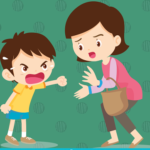In the complicated realm of childhood development, one of the most hard elements for parents and caregivers is helping children manage with rage. Children, as they develop and learn, frequently deal with tremendous emotions, and rage is a normal component of this emotional spectrum. However, it’s crucial to help youngsters in understanding and controlling their anger constructively. In this thorough book, we will study effective anger management methods geared for youngsters. These tactics attempt to equip children to understand, express, and deal with their anger in healthy ways.
Understanding Anger in Children
Recognizing the Signs of Anger :
Recognizing signs of anger in children is crucial for parents and caregivers. These manifestations may include temper tantrums, outbursts, violence, and stubbornness. It’s essential to discern between age-appropriate displays of displeasure and behaviors that may require intervention. By staying attuned to these signs, adults can provide timely support and guidance, fostering emotional well-being in children.

Why Kids Get Angry :
Children experience anger for various reasons, stemming from dissatisfaction, unmet demands, exhaustion, hunger, or feeling misunderstood. Understanding these fundamental causes is the initial step in helping children manage anger appropriately. By recognizing and addressing the underlying triggers, parents and caregivers can create a supportive environment that empowers children to express and navigate their emotions constructively. Acknowledging the diverse sources of anger in children enables adults to tailor their responses effectively, promoting a healthy emotional development and enhancing the child’s ability to cope with and understand their feelings.
Read also: From Stress to Success: The Benefits of a Parenting Class
Effective Anger Coping Skills
Identify and Label Feelings :
Teaching youngsters to comprehend and articulate their emotions is a fundamental anger management technique. Empower them to express their feelings verbally, such as saying, “I am angry,” instead of resorting to physical displays of rage when upset. This practice enhances emotional intelligence and encourages open communication about their emotional states. By fostering a vocabulary for emotions, children develop a valuable skill in navigating and understanding their own feelings, promoting a healthier approach to anger management and interpersonal relationships.
Deep Breathing Exercises :
Deep breathing serves as a simple yet potent technique for assuaging anger. Instruct youngsters to engage in calm, deep breaths during moments of distress. The process of inhaling deeply through the nose and exhaling through the mouth provides a practical method to manage heightened emotions. By incorporating deep breathing exercises, children gain a valuable tool for self-regulation, enabling them to navigate anger more effectively and fostering emotional well-being. This technique not only promotes a sense of calm but also instills a lifelong skill for managing stress and emotional turbulence.
Count to Ten :
Counting to ten acts as a swift intervention to allow youngsters a moment to regain composure before reacting impulsively in anger. Encourage children to count slowly and deliberately when they sense agitation rising. This simple yet effective practice cultivates self-control, providing a brief pause for reflection and preventing impulsive actions driven by anger. By incorporating counting to ten into their coping mechanisms, children develop an invaluable skill in managing emotional responses, promoting thoughtful decision-making, and enhancing emotional intelligence.
Use “I” Statements :
Empower youngsters to express their feelings using “I” statements as an effective means of communication. Encourage phrases like “I feel angry when…” instead of placing blame on others. This approach fosters clear communication and effective problem-solving by shifting the focus to personal emotions. By utilizing “I” statements, children learn to express themselves assertively, facilitating a constructive dialogue around their feelings and contributing to a healthier resolution of conflicts. This skill not only aids in anger management but also builds a foundation for positive communication habits that can benefit them throughout their lives.
Time-Outs :
Recommend the use of time-outs when children feel overwhelmed by anger. Establishing a designated space for time-outs enables individuals to step away from a situation, providing an opportunity to regain composure. It’s crucial to emphasize that time-outs are not punitive measures but rather a chance to settle down and collect one’s thoughts. This strategy teaches children the importance of self-awareness and proactive self-regulation. By incorporating time-outs into their anger management toolkit, children learn to navigate challenging emotions effectively, fostering emotional resilience and contributing to a healthier approach to conflict resolution.
Engage in Physical Activities:
Encourage physical activities such as jumping, sprinting, or using a stress ball to release built-up anger. Participating in these activities provides an outlet for emotional energy, promoting a constructive channeling of frustration. By engaging in physical activities during moments of unhappiness, youngsters learn to redirect their emotions in a positive and productive manner. This strategy not only aids in anger management but also contributes to overall physical well-being, highlighting the interconnectedness of physical activity and emotional regulation. It instills in children the understanding that movement can be a powerful tool for managing and expressing emotions, fostering a holistic approach to emotional well-being.
Journaling :
For older children, encourage the use of journaling as a helpful tool for coping with anger. Urge them to write down their emotions, the triggers for their anger, and potential solutions. This practice promotes self-reflection, enhancing emotional awareness and understanding. Journaling serves as an outlet for processing complex emotions, allowing children to explore the roots of their anger and work towards constructive resolutions. By incorporating journaling into their coping strategies, older children develop a valuable skill for navigating and managing anger, fostering emotional resilience and self-awareness. This introspective practice contributes to the development of healthy emotional habits that can benefit them well into adulthood.
Conclusion
Helping children develop anger coping skills is a great gift that empowers them with vital emotional intelligence and self-regulation abilities. By identifying the indications of anger, providing good coping methods, and addressing specific triggers, parents and caregivers may help children toward healthy manifestations of anger. This comprehensive approach fosters a foundation for lifelong emotional well-being, empowering children to handle and understand their feelings constructively. Ultimately, the investment in cultivating these anger coping skills equips children with valuable tools for navigating the complexities of their emotions, promoting resilience, and facilitating harmonious interpersonal relationships.
Read also: Understanding Strict Parenting: Benefits, Drawbacks, and Balance





